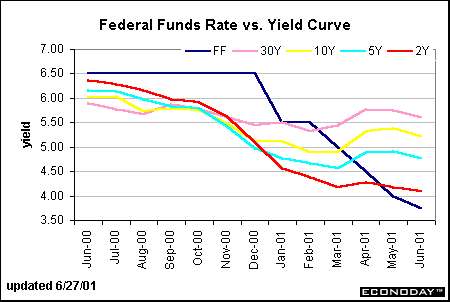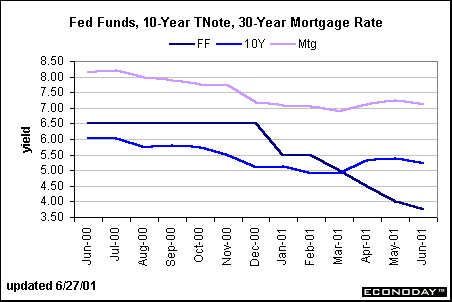Yields on Treasury securities can tell us a variety of things about the economy. A normal yield curve typically has short-term rates lower than long-term rates because investors must be compensated for their willingness to lend for a longer time period. This means that the yield on a 2-year note will usually be lower than the yield on a 10-year note or a 30-year bond. However, as economic conditions change, the shape of the yield curve will also shift.
Investors often anticipate trends and it isn't unusual to see Treasury yields fall more rapidly than the federal funds rate that is governed by the Federal Reserve. In May last year, the Fed raised its target for the federal funds rate to 6.50 percent. Market players were already anticipating that the Fed would not only stop raising rates, but also eventually start to ease. The chart below shows that the fed funds target was stable between June and December, but Treasury yields fell - in some cases by more than one hundred basis points - even before the Fed decided to ease policy on January 3, 2001. Given that the Fed maintained its aggressive easing policy in the first half of the year, one would think that bond investors would react favorably and push yields down further. Indeed yields did fall on the 2-year and 5-year Treasury notes, but remained stable on the 10-year note and 30-year bond through the spring. By the time the Fed cut rates three times, yields on the longer term issues were already starting to inch up. Bond yields reflect economic conditions, but also reflect expectations of inflationary pressures. And bond investors were beginning to worry that inflation would flare up with the Fed's aggressive policy.

At Wednesday's close, the yield on the 30-year bond was 4 basis points lower than Tuesday's close, but the fact is that yields were lower on Friday, June 22. Furthermore, yields on the other Treasury securities (shorter maturities) were all higher on Wednesday than they were just three days before. It isn't unusual for Treasury yields to rise after a Fed rate cut, because usually expectations are met.
Economic impact
Consumers can't borrow money at the federal funds rate. If they could, there would be no question that it is cheaper to borrow today than it was six months ago. Consumer loans are tied to various market rates. To some extent, consumer loans are tied to the federal funds rate when they are tied to the prime rate. Several banks lowered their prime rate from 7 percent to 6.75 percent upon the Fed's announcement. Home equity loans are tied to the prime, so consumers will benefit. However, most credit card loan rates don't usually feel the impact of Fed rate actions.
One would expect mortgage rates to move in tandem with the federal funds rate, but mortgage rates are tied to Treasury yields. The yield on the 30-year fixed rate mortgage loan did move down in the second half of 2000 with the yield on the 10-year note. It fell slightly in early 2001, as did the 10-year note. But notice that the 10-year note yield (and the mortgage rate) was no longer affected by the declining federal funds rate target after March.

The housing sector has remained rather strong this past year, and picked up a little steam at the end of 2000 and beginning of 2001. Yet, if the Fed intends to have any impact on the housing sector these days, they are failing their mission.
And what about equities?
The equity market is in a bind as well despite the fact that the Fed managed to cut the fed funds rate target by 275 basis points these past six months. Lower interest rates typically benefit almost everyone. Lower borrowing rates tend to generate greater demand on big-ticket purchases and this spurs consumer spending. Improved consumption generates higher corporate profits. The equity market is looking for profits. Today, equity traders weren't looking for a 25 or 50 basis point cut, but rather an indication in the Fed's statement that they saw signs of economic recovery. In fact, the statement was quite negative with respect to corporate profits. Not surprisingly, the immediate impact of the Fed's statement was negative on the stock indices, although they had recovered marginally by the end of the day.
The bottom line
Equity markets are looking for corporate profits, pure and simple. Signs of strength in economic indicators would be better news for equity investors than signs of lower interest rates. Bond investors apparently aren't too thrilled with the Fed's rate cuts because interest rates are higher now than they were a few months ago. It's difficult to see how any consumer loan rate tied to Treasury securities will benefit from the Fed's rate cut.
Evelina M. Tainer, Chief Economist, Econoday